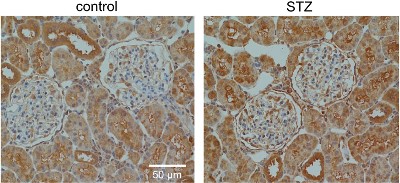Overview
- Peptide (C)DNVKYYNLARIKWD, corresponding to amino acid residues 573-586 of mouse TRPC6 (Accession Q61143). 2nd extracellular loop.
- Rat brain lysate (1:200).
 Western blot analysis of rat brain lysates:1. Anti-TRPC6 (extracellular) Antibody (#ACC-120), (1:200).
Western blot analysis of rat brain lysates:1. Anti-TRPC6 (extracellular) Antibody (#ACC-120), (1:200).
2. Anti-TRPC6 (extracellular) Antibody, preincubated with TRPC6 (extracellular) Blocking Peptide (#BLP-CC120).
- Rat kidney sections (1:50) (Ilatovskaya, D.V. et al. (2015) Sci. Rep. 5, 17637.).
- Rat live PC12 cells (1:50).
The Transient Receptor Potential (TRP) superfamily is one of the largest ion channel families and consists of diverse groups of proteins. In mammals, about 28 genes encode the TRP ion channel subunits. The mammalian TRP superfamily comprises six subfamilies known as the TRPC (canonical), TRPV (vanilloid), TRPM (melastatin), TRPML (mucolipins), TRPP (polycystin) and the TRPA (ANKTM1) ion channels1-4.
The TRPC subfamily consists of seven proteins named TRPC1 to 7 which can be further divided into four subgroups based on their sequence homology and functional similarities: TRPC1, TRPC4, TRPC5 TRPC3, TRPC6, TRPC7 and TRPC22,5. They are highly expressed in the central nervous system and to a lesser extent in peripheral tissues.
TRPC6 can form heterotetramers with TRPC3 and TRPC7. It is primarily expressed in brain, lung and muscle. High levels of expression of the channel were also found in human platelets. Recently it was reported that TRPC6 is also expressed in the kidney where a mutated channel has been implicated in kidney failure disease6,7.
Application key:
Species reactivity key:

Expression of TRPC6 in rat kidney cortex sections.Immunohistochemical staining of rat kidney sections using Anti-TRPC6 (extracellular) Antibody (#ACC-120). TRPC6 staining is detected in podocytes and darker patches are observed in hyperglycemic rat subjected to STZ treatment.Adapted from Ilatovskaya, D.V. et al. (2015) Sci. Rep. 5, 17637. with permission of Nature Publishing Group.
